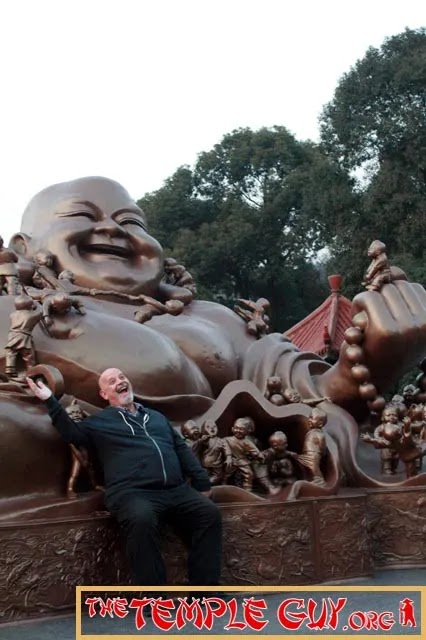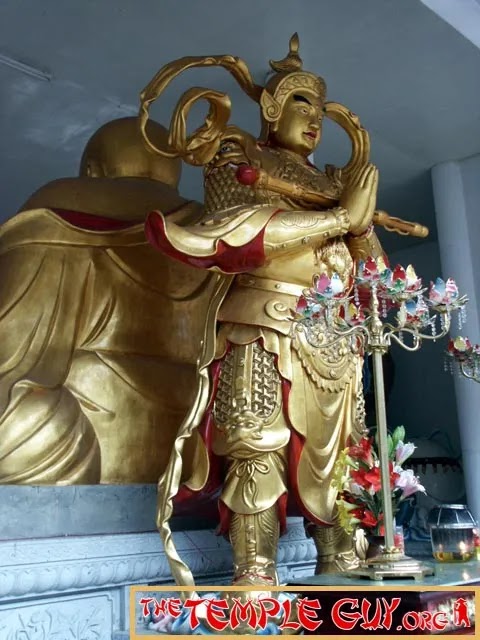 |
| MASSIVE "Laughing Buddha" (see the people at his base?), Xingguo Chan Temple, Ji'nan, Shandong |
When you visit a Chinese Buddhist temple, you may wonder, "Who's the fat guy? And who's that scowly looking dude behind him?"
He's usually called a Buddha, but he's not one--yet.
He's the Buddhist version of Santa Claus.
He's the favorite garden ornament of thousands.
And in Japan, he's both a Bodhisattva and a "Lucky God"--but in very different guise.
He's the Laughing Buddha, and he's the main focus of Episode 003 of...
TEMPLE TALES!
Buddha or Bodhisattva?
Let's clear up a huge misconception right away. The so-called "Laughing Buddha" is not a Buddha at all. Let's dig into some Buddhist mythology to see why.
There has been only one "Buddha," or awakened person, in history. He was Siddhartha Gautama, and lived on the India/Nepal border roughly 2,500 years ago. But since his passing, many myths have arisen, and are repeated with the same conviction that members of any religion feel when stating their myths. (Incidentally, these myths are from the Mahayana tradition, generally found in East Asia; southern Buddhist traditions may vary.)
This particular myth says that the historic Buddha (also called Shakyamuni, meaning "Sage of the Shakya Clan") was the most recent in a line of Buddhas that reaches back--scientifically speaking--to before the earth was formed. A Buddha teaches, and when his teaching fades out and is lost to the world, another Buddha comes to restore it.
While on earth, each Buddha in this chain, they say, tags--not chooses, but recognizes the development of--his successor. And the historic Buddha Shakyamuni recognized one of his followers, named Maitreya (meaning "The Compassionate One"), as coming next--some say 5.67 billion years after Shakyamuni's passing (!)
So Maitreya--the proper Sanskrit name of the "Laughing Buddha"--is not a Buddha yet, but will be the next one. This makes him, strictly speaking, a Bodhisattva, or a "Buddha to be," not a Buddha per se.
Fat or Fit? Another misconception
 |
| The Ascetic Shakyamuni, Daxingshan Temple, Xi'an, Shaanxi |
Ask the person on the street, "What did the Buddha look like?" and you'll probably hear something like, "Uhhh… He was a fat, jolly, bald guy." Some may add that he carried a sack, or had children around him.
BUZZ! Incorrect answer.
There is no reason to believe that the historic Buddha was of anything other than normal build. Furthermore, he said of himself that, when he was undergoing extreme ascetic practices before his enlightenment, he was down to eating one grain of rice a day, and grew so thin that he could touch his backbone through his abdomen.
Try THAT, Fat Man.
The Maitreya who lived in India, too, is traditionally held to have been slim.
So why the confusion?
Life in China
 |
| Me and the LB, Lingshan Scenic Area, Wuxi, Jiangsu |
According to the myths, Maitreya currently resides in the Tushita Heaven, where he is waiting for his birth into the lifetime in which he will receive Buddhahood. (Shakyamuni, and all Buddhas before him, also hung out in Tushita before their final births.) This "Heaven" is a place accessible to those who meditate with gusto.
But, the legends say, Maitreya comes down to check things out on earth from time to time. Many have claimed to be incarnations of Maitreya, including Wu Zetian, empress of China; Gung Ye, a Korean warlord; and L. Ron Hubbard, of Scientology fame.
But the most famous claimant by far was born a portly monk in early tenth-century China--dying, they say, in 918. A text from 988 says he carried a cloth sack (as essential to his iconography as his belly), so he was called the "cloth sack" (Budai) monk.
This Budai's sack cinches his claim as the Buddhist Santa Claus, as he is said to have dispensed good things from it, especially to the poor. And his belly--which probably could shake like a bowlful of jelly--is able to absorb all the negativity around him. Suck in the bad vibes, hand out the goods!
He was also a little "simple," as we'll see in our final story today, and was often found playing with children. Some legends claim that the shoes he wore could provide hints to the weather forecast: he wore straw sandals when rain was coming, and wooden clogs if the weather would be dry.
Now, when this big-hearted (and big-bellied) fellow approached death, as was the custom he wrote a final verse. It went a little somethin' like this:
Maitreya--I mean the REAL Maitreya--
Has shown up gazillions of times,
Teaching whoever he could--
Even when they didn't see him for who he was.
(A very free translation/paraphrase by yours truly.)
And so, since his death, Budai has been recognized in China as the "real Maitreya."
Japan: Miroku and Hotei
 |
| Miroku Bosatsu, 7th century, Koryuji Temple, Kyoto, Japan (Wikipedia) |
Folks seeking Maitreya in Japan may experience double vision.
It seems that the "proper" form of Maitreya--the slim one--made it to Japan pretty early. A well-known statue (and a National Treasure) at Koryu-ji Temple in Kyoto dates to the seventh century. Remember, Budai didn't live (if he lived at all) until the early tenth century, so there's no way he could have been known as early as the seventh. In fact, evidence suggests that the Fat Guy didn't "arrive" in Japan until the Edo period, which started in 1601.
So when he finally did arrive, there was no room for him at the inn, so to speak. What did those clever Japanese do? They found him a place amongst a group known as the Shichi Fukujin, the "Seven Lucky Gods." And they kept the name Budai, the characters for which are pronounced in Japanese "Hotei." Few Japanese realize that Miroku Bosatsu (Maitreya Bodhisattva) and Hotei are essentially the same guy.
 |
| Hotei has a picnic with the other six fukujin (from a Tokyo pilgrimage stamp sheet in my collection) |
"Our" Family Buddha... Or...
 |
| Mom's Hotei (photo by the current owner--my sister!) |
A long, long time ago, I can still remember how my mom had a Buddha in the garden. Turns out she's not the only one: Garden Buddhas are a hot item.
So, when I conceived of this piece, I asked my brother to take a picture of the one in Mom's garden, but it turns out: he's moved! (The Buddha, not my brother.) And he left a forwarding address--at my sister's house! So she took the picture.
Now, I hadn't really taken a close look at that statue since I learned all this stuff. So, when I saw my sister's picture, guess what? He's not, as I expected, "The Laughing Buddha" at all! The fan in his hand makes me think he's actually Hotei.
I guess my mom was at a neighbor's house down the street years ago, and saw it in her garden, and said, "Oooo, I like that!" And the woman said she didn't, and gave it to my mom.
Then, pretty much the same thing happened with my sister (though my mom did like it): When my sister expressed interest in having the statue, my mom said, "Take it."
That Hotei really gets around!
My mom recently pointed out how weather worn he looks; sitting outside for decades will do that to you.
About That Title…
 |
| Weituo behind Maitreya, Huayan Temple, Ningde, Fujian |
There's so much more to say about Maitreya: the number of rebellions in China perpetrated in his name; the speculation that his name and character derive from the Indo-Iranian god Mithra; his place in modern Theosophy and its successors; and much more.
But I want to end with a quaint little story--with a moral to it.
It seems that Budai, the generous monk, was put in charge of a temple. With such a giving nature, it wasn't long before he had given away all the temple's assets. When hungry people came, he fed them; when poor people came, he gave them cash. Soon the ne'er-do-wells found out, and started taking everything they could get their hands on--even nabbing most of the statues!
It got so bad that the monks kowtowed before the Buddha on the main altar (he hadn't been taken yet!) and told him their plight. In compassion, the Buddha--hearing their pleas in Heaven--sent down a helper to set things right.
The "helper" was Weituo, a fierce-looking celestial general now considered a protector of temples. He brought balance to the temple administration, convincing Budai that to be too generous was to waste the offerings given by devotees--while he simultaneously kicked butt on the abusive visitors.
Today, when we visit most Chinese Buddhist temples, Maitreya is there to greet us: "Come in!" he seems to say. "Make yourself at home! Help yourself to whatever you'd like!"
But as you leave, Weituo is standing behind him and growling, "But you'd better not take too much!"
The moral? As my old teacher Dr. Warnasuriya used to intone: "The Buddha was a teacher of the Middle Way." Balance in all things. As the Muslims say, "Trust Allah--but tie up your camel."
Alrighty! That about wraps up this episode of Temple Tales. I hope you had some fun.
Until next time, may you and your loved ones and all sentient beings be well and happy.
Adios, Amigos!
QUESTIONS:
Questions for Episode 003: The Laughing Buddha and the Scowling General
- Do you, or does anyone you know, have a statue of "the Laughing Buddha"? Could you share a photo of it?
- How do you think we ended up with the very Maitreya-like image of Santa Claus, despite Buddhism not being widely known in the US when Santa "arrived"? (Side question: Did you encourage your kids to believe in Santa?)
- What do you think about the story and its moral? Should generosity have limits? What should they be?
- For those more familiar with Buddhism: Do you think the Buddha/Bodhisattva distinction is important? Why or why not?
Please feel free to respond to any or all of the questions. This is also a good place for you to ask YOUR questions, or to comment on this episode of the Newsletter/Podcast.
GET MORE:
- Listen to the audio version of this post at Archive.org. (10:12 min)
- In the next episode: Hear how the Buddha often taught in parables, not unlike those of Jesus.
- You can still subscribe to the Temple Tales Newsletter; though I'm not actively publishing, you never know!

No comments:
Post a Comment